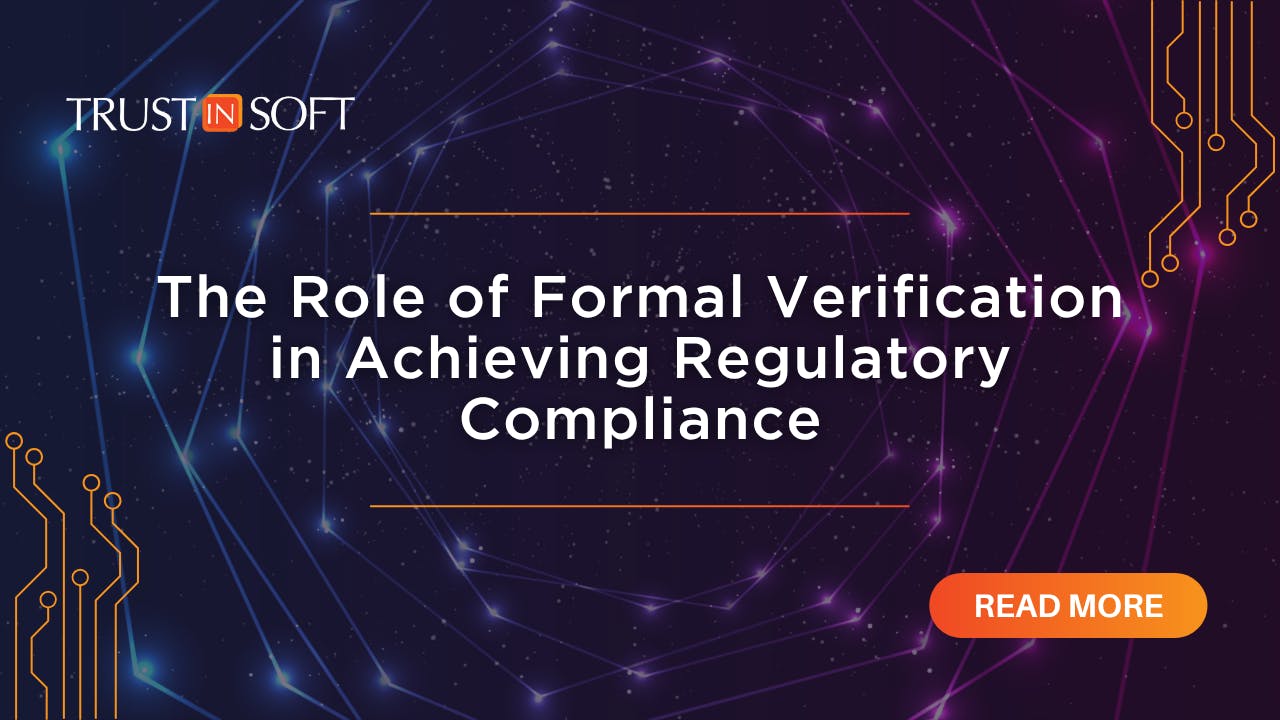Formal Verification: Your Key to Regulatory Compliance (ISO 26262, DO-178C)
May 28, 2025

Key Takeaways
- Formal verification ensures compliance with industry standards like ISO 26262 and DO-178C, crucial for safety-critical systems.
- TrustInSoft's formal verification tools offer mathematically proven memory safety, reducing development costs and enhancing software reliability.
- Integrating formal verification early in the development workflow can lead to significant ROI by minimizing defects, recalls, and time-to-market.
The Landscape of Regulatory Compliance
Navigating the complex world of regulatory compliance requires a thorough understanding of key international standards and regulations. Here's an overview of some critical standards:
ISO 26262
ISO 26262 focuses on functional safety for road vehicles. It aims to minimize accidents and deaths related to automobile safety by defining Automotive Safety Integrity Levels (ASILs). Formal verification aids in achieving the required ASIL levels, ensuring that automotive systems meet stringent safety requirements.
DO-178C
Addressing software considerations in airborne systems and equipment certification, DO-178C defines Design Assurance Levels (DALs) that are critical in ensuring compliance and protecting passengers and crew. Meeting these levels is essential for the safety and reliability of airborne systems.
ISO/SAE 21434
As cybersecurity becomes increasingly important in automotive systems, ISO/SAE 21434 focuses on cybersecurity engineering for road vehicles. Resources like Auto-ISAC best practice guides can further strengthen cybersecurity practices in this domain.
Cyber Resilience Act (CRA)
Cyber Resilience Act (CRA) defines essential cybersecurity requirements for digital products in the European market. Compliance with the CRA is crucial for ensuring the security and resilience of digital products.
Consequences of Non-Compliance
- Financial penalties and legal repercussions.
- Reputational damage and loss of customer trust.
- Increased risk of safety-critical failures and potential harm to individuals.
TrustInSoft's formal verification tools and services help organizations navigate these complex regulatory landscapes, avoid the pitfalls of non-compliance, and ensure that their software meets the highest standards of safety and reliability. TrustInSoft Analyzer provides formal verification-backed hyrbid code analysis that mathematically guarantees the absence of memory vulnerabilities and runtime errors.
Understanding Formal Verification
Formal verification is a rigorous mathematical technique used to prove the correctness of software. Unlike traditional testing methods, which rely on running test cases, formal verification uses mathematical models and algorithms to exhaustively analyze the software and identify potential defects. TrustInSoft guarantees zero memory safety vulnerabilities, ensuring compliance with security standards.
Benefits of Formal Verification
- Early detection of defects: Reduces development costs by identifying issues early in the development cycle.
- Improved software reliability and safety: Ensures that the software functions correctly under all conditions.
- Enhanced security: Identifies vulnerabilities that could be exploited by attackers.
- Increased confidence in meeting regulatory requirements: Provides evidence that the software complies with industry standards.
TrustInSoft Analyzer provides mathematically proven memory safety, eliminating runtime errors and vulnerabilities that other tools miss. This ensures that your software is free from defects and meets the highest standards of quality. TrustInSoft empowers teams to eliminate runtime errors, memory leaks, and vulnerabilities using formal verification.
How Formal Verification Supports Regulatory Compliance
Formal verification techniques can be mapped to specific requirements within each standard, providing a robust approach to compliance:
- ISO 26262: Formal verification supports refinement checking for design-time verification of compliance and verifies software safety requirements for consistency (ISO 26262 part 6 clause 6.4.7). It helps achieve specific ASIL requirements, ensuring automotive systems meet stringent safety standards.
- DO-178C: Formal verification can be used to satisfy objectives at different Design Assurance Levels (DALs), ensuring compliance with aviation software standards.
- ISO/SAE 21434: Formal methods can verify the security of automotive software components, addressing the growing importance of cybersecurity in automotive systems.
- Cyber Resilience Act (CRA): Formal verification can demonstrate adherence to the CRA's cybersecurity requirements, ensuring compliance with European cybersecurity regulations.
TrustInSoft Analyzer automates the generation of compliance reports for standards like ISO 26262, AUTOSAR, and DO-178C, streamlining the compliance process and reducing the burden on development teams.
Integrating Formal Verification into the Development Workflow
Challenges and Solutions
- Dealing with complex codebases: Formal verification tools must be able to handle large and complex codebases.
- Managing false positives: TrustInSoft's low false positive guarantee ensures that you can focus on real issues without being distracted by false alarms.
- Ensuring scalability and performance: Formal verification tools must be able to scale to meet the demands of your development process.
TrustInSoft offers seamless integration with Agile, CI/CD, and V-model workflows, making it easy to incorporate formal verification into your existing development processes.
The ROI of Formal Verification
The return on investment of formal verification can be substantial:
- Reduced testing effort and costs: By identifying defects early in the development cycle, formal verification reduces the need for expensive testing and debugging later on.
- Lower risk of defects and recalls: Formal verification helps prevent costly defects and recalls by ensuring that the software is free from errors and vulnerabilities.
- Improved time-to-market: By streamlining the development process and reducing the risk of defects, formal verification helps accelerate time-to-market.
- Enhanced brand reputation: By ensuring the safety and reliability of your software, formal verification enhances your brand reputation and builds customer trust.
Consider the cost savings achieved by reducing expensive post-release debugging and security patches.
The Future of Formal Verification and Regulatory Compliance
As software continues to play an increasingly critical role in safety-critical systems, the importance of formal verification will only continue to grow. Emerging trends and technologies in formal verification will further enhance its capabilities, while the evolving landscape of regulatory compliance will drive the need for more rigorous verification techniques.
Formal verification is essential for achieving regulatory compliance and building safer, more reliable, and more secure software. By integrating formal verification into your development workflow, you can reduce the risk of defects, lower development costs, and improve time-to-market.
Explore TrustInSoft's formal verification solutions and contact us for a demo or consultation to learn how we can help you achieve your regulatory compliance goals and ensure the safety and reliability of your software.